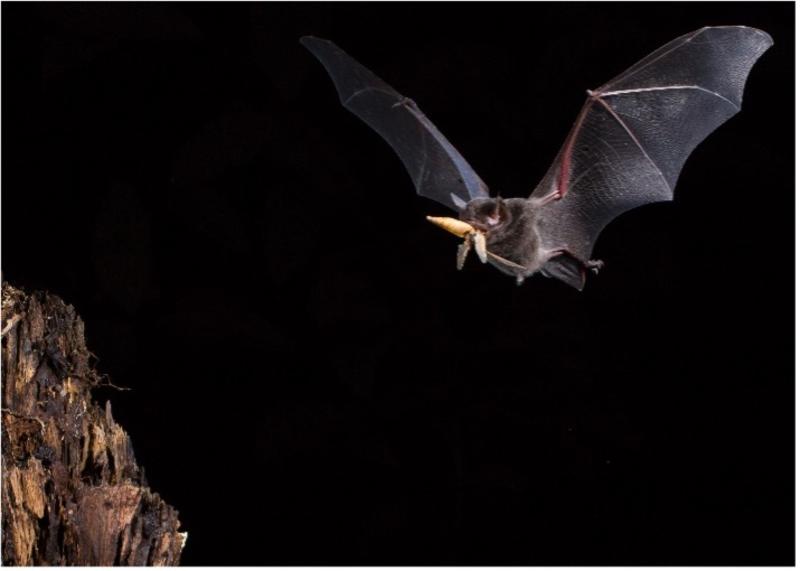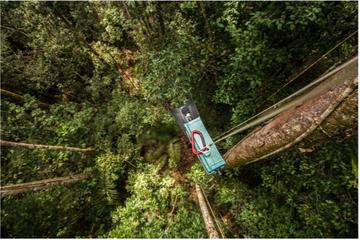
Mustached bat flying with prey
Both studies were conducted at the Biological Dynamics of Forest Fragments Project (BDFFP) in Brazil, an experimentally fragmented landscape created in the late 1970s in which a series of forest fragments of different sizes (1, 10 and 100 hectares) were isolated from old-growth, primary rainforest, initially to make way for cattle pastures. The cattle ranches soon became unproductive and were abandoned, and the fragments are now embedded in large swaths of tall regrowth forest - secondary forest - which has been regenerating for over 30 years.
Brazil has a rich and diverse bat fauna, with over 180 known species. Over half of these are aerial-hawking bats, species which hunt their airborne insect prey in flight, and which until recently, have been largely excluded from bat studies because they require sampling via acoustic methods instead of the traditional mist netting approach.

Bat detector deployed in the forest canopy
Using a unique acoustic dataset of over 500,000 calls, the international team of researchers set out to assess how different facets of the diversity of the aerial insectivorous bat assemblage responded to fragment size and habitat disturbance. They also investigated whether edge effects – ecological changes and alterations in the environment often observed at the boundary of two contrasting habitats - were still evident across the interface of primary-secondary forest despite their now relatively small differences in forest structure.
The two studies suggest that the aerial insectivorous bat assemblage at the BDFFP could be approaching a point of recovery after 30 years of regeneration, with the advanced secondary forest buffering the pervasive effects of fragmentation. Both studies highlight the conservation value of secondary forests and the importance of retaining primary forest fragments of appropriate size to protect source populations within human-modified landscapes which are exposed to deforestation and fragmentation pressures.
“Bats comprise around one fifth of all mammal species and the Amazon is home to one of the richest bat faunas on the planet. They display wide variation in morphology, foraging behavior, and habitat use, making them an excellent model group for assessing how species respond to habitat modification. The responses exhibited by bats offer important insights into the responses of other taxonomic groups.” says Ricardo Rocha, Associate Professor in the Department of Biology, University of Oxford. He adds:
“The recovery that we have documented in aerial insectivorous bats mirrors the patterns observed for other bat groups as well as beetle and bird communities at the BDFFP. These parallel trends reinforce the idea that the benefits of forest regeneration are far from taxon-specific, and suggest that forest restoration can ameliorate some of the harm inflicted by humans on tropical wildlife”
You can read more about these two papers, published in Landscape Ecology and PLOS One.